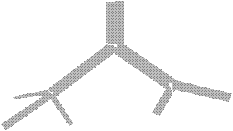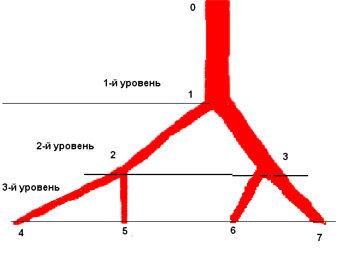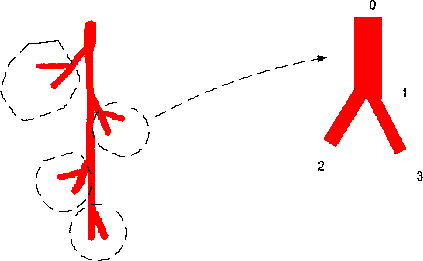Donetsk National Technical University


|
|
||||||||||||||||||||||||||
|
ABSTRACT |
|
Urgency Studying of the basic morpho-functional principles of the organization of an arterial bed of the big circle of a circulation, is an actual scientific problem as vascular diseases substantially cause a mortality and an invalidism of the population. High frequency of occurrence and special gravity of these of disease demand improvement of knowledge in this area and development of new, effective ways of their diagnostics and treatment, and also forecasting of results of surgical correction of hemodynamic frustration. The purpose and problems The purpose and a problem master's works is creation soft-hard complex for calculation of optimum parameters of morpho-functional principles of the organization of an arterial bed of the big circle of a circulation, on the basis of genetic algorithm. For achievement of an object in view following problems are certain: 1 To study morphometric laws of arterial beds of is functional-various organs of the big circle of a circulation (a sceletal muscle, heart, kidneys, a brain), influencing on hemodynamic resistance. 2 To frame the mathematical models describing laws of a structure of arterial beds of the set forth above organs adapted for use of genetic algorithm. 
The practical importance The formulated general and individual morpho-functional principles of the organization of arterial beds of is functional-various organs of the big circle of a circulation will promote the best comprehension of the laws underlying their structure and functioning. The simulated geometrical parameters of model of vascular beds can be used as the formalized estimated standard of a normal structure of beds of the set forth above organs. Quantitative data about UKBS can serve an artery a starting point for the further researches of its mechanical properties and behaviour at a dilatation and destruction. Use of the framed mathematical model of a structure of an arterial bed in conditions of experiment on a computer will enable receptions of new data on various aspects of blood flow. Use in the future in clinical conditions: Mathematical models of a structure of arterial beds of is functional-various organs of the big circle of a circulation will allow to diagnose in an automatic regimen their pathology, to prognosticate volume and the blood supplied area a site, to judge adequacy of blood supply, in particular, use of mathematical model of an arterial bed of a sceletal muscle will allow to plan rationally volume of transplantation musculocutaneous flap. Practical application of mathematical model of a hemodynamic in conditions of experiment on a computer will enable objective planning of actions on reconstruction of patholologically changed arterial bed. The review of existing agents shows, that today there are no software which would allow on the basis of data about entrance diameter of a vessel to restore all vascular tree of the given organ, therefore the solved problem is exclusively important for modern medicine. Theoretical data For the first time the problem of functional anatomy of vascular bifurcations has been formulated in 1878 in the thesis for a doctor's degree of the German anatomist and embryologist Wilhelm Ru. On the basis of the observations it has come to conclusion, that the form of a vascular bifurcation is similar to the form of a jet of the liquid following from an aperture of a tube. It for the first time had been established communication between size of an angle of a bifurcation of an arterial dichotomy and diameters of lumens of a maternal trunk and its affiliated branches. The found out laws of a structure of arterial dichotomies it has formulated " rules Ru " in the form of the rules which have received in the special literature the name: 1. If some artery branches on two identical branches they depart under identical angles to the basic trunk. 2. If one of two branches is more thin another thicker branch, or continuation of the basic artery, the smaller angle, than a thin branch forms with the basic trunk. 3. All branches which are so small, that they practically do not reduce the basic trunk, depart from it under a greater angle. For an explanation of these corrected V. Ru has offered a hypothesis that the design and functioning of vascular system answers a principle of the minimal expenses of the biological material spent for its construction, and a principle of the minimal work necessary for promotion after it of a blood. Thus arterial dichotomies under influence of the hemodynamic factor accept configurations which for the given conditions are best of all possible. Optimum. English physiologist Murray C. D. In 1926 used graceful mathematical reception for the analysis of a vascular dichotomy. It has allowed it, avoiding complex calculations to solve the problem on a parity of diameters and angles in a vascular dichotomy at which the minimum of losses of energy is reached. Murray C. D. Has deduced the formula, allowing to calculate optimum size of an angle of a bifurcation in a vascular dichotomy. Model Murray C. D. Enables quantitatively to explain empirical rules Ru. |
 Fig. 1.1. The scheme of branching of a spending element. |
|
In a new wording they have been formulated in the form of a set of the equations of branching of
an any artery with a diameter d0 (Fig. 1.1) on two
affiliated arteries with diameters d1 And d2
And angles of branching1 And2 Accordingly:
1. If d1≈d2, That1≈α2; 2. If d1<d2, That1>α2; 3. If d1<<d2 And d0≈d2, That1≈90° , α2≈0. If to calculate parameters of branching OABC providing delivery of a liquid from point O in points B and C (fig. 1.1) with the minimal expenses of energy for angles of optimum branching it is possible to receive:  (1.1). (1.1). For formalization of the description of an arterial bed it was represented in the form of bound the column which tops corresponded to points of bifurcations of arteries, and with ribs - to arterial segments. |
 Fig. 1.2. The scheme of measurement of arterial bed site: Di - diameter of a maternal artery; dmin - the minimal diameter of a branch; dmax - the maximal diameter of a branch; L - length of an arterial segment; CM - the attitude of number of the arteries leaving a point of a bifurcation, to number of the arteries entering into it. |
|
At the initial stage of statistical research extraorganic
part of an arterial bed represented as the design consisting of interconnected
arterial segments. The file of data contained the following information: 1) Gr - number of generation - a serial number of again formed group of arteries to which the given segment concerns; thus "artery" meant the linear design consisting of affiliated segments with the greater internal diameter (if one of conditions is not carried out: D/dmax<3, dmax<>dmin Or dmax>0,1, That the artery comes to an end); 2) i - a level of division: again formed series of arterial segments (fig. 1.3); 3) Internal diameter (D) an arterial segment (mm), 3) Length (L) an arterial segment (mm) (distance between two branchings); 4) The factor of form FF (rel.un) - the attitude of size of length of an arterial segment to size of its radius (rel.un.); 5) The area of cross-section section of an arterial segment (H = *D2/4) (Mm2); 6) The area of an internal surface of an arterial segment (S = π*D*L) (mm2); 7) Volume of an internal cavity (V=H*L) an arterial segment (mm3), 9) R0=128*L / π*D4 - Morphological component of hemodynamic resistance (MSGS)< (mm3) from Puazeyl equation (1.1); 10) CM - factor  Fig. 1.3. Schematic representation of an arterial bed site. The note: segments of 1-st level of division: 0-1; segments of 2-nd level of division: 1-2 and 1-3; segments of 3-rd level of division: 2-4, 2-5, 3-6, 3-7; segments of 1-st generation: 0-1, 1-3, 3-7; segments of 2-nd generation: 1-2, 2-4, 3-6; segments of 3-rd generation: 2-5. Augmentations of quantity of arteries, it is peer - to number of the affiliated branches which have formed as a result of division of a maternal arterial segment (rel.un.). In the subsequent extraorganic part of an arterial bed of the big circle of a circulation surveyed as the design consisting of interconnected arterial bifurcations (fig. 1.4). Each bifurcation form: the arterial segment entering into a point of branching (maternal), arterial segments, leaving it (affiliated), and actually a point of a bifurcation. As the characteristic of a degree of branching used a parameter of SM - factor of augmentation of quantity of arteries. It could be peer 2 - a dichotomy, 3 - trihotomy and 4 - quadrotomy.  Fig. 1.4. The scheme of representation of an arterial bed as the system consisting of arterial dichotomizing bifurcations. Notes: 0-1 - a maternal arterial segment, 1-2 - an affiliated arterial segment with the greater diameter, 1-3 - an affiliated arterial segment with smaller diameter, 1 - a point of a bifurcation (actually a dichotomy). The principle of the minimal expenses of a biological material and energy is put in a basis of theoretical constructions of an ideal arterial tree. It was supposed, that function of a vascular bifurcation is carrying out of a blood with the minimal expenses of energy. Realization of this principle is carried out and shown, in opinion of many authors by the coordination of sizes of internal diameters of the arteries making a vascular bifurcation. On the basis of described above the theory program Vasculograph which models structure of a vascular bed using some average value of parameters of model for the certain organs however an optimum of model not always is constructed corresponds to average indices therefore it is necessary to use such kind of search of the optimum decision at which possible to pick up the optimum decision without full search of all possible value. With a method which such search provides is genetic algorithm working on set of material numbers. As fitness-functions estimating parameters of model it is possible to take such parameters as resistance and a minimum of the charge of a material. To estimate the charge of a material it is enough to estimate the attitude of volume of a vascular bed to the area covered by it, than this attitude is less than themes the charge of a material less. However it is necessary to consider also also such parameters as hemodynamic resistance of a bed, volumetric rate and pressure of a blood which also aspires to a minimum for effective carrying out of a blood on vessels. What to estimate parameters of a hemodynamic of the constructed bed it is necessary to use a following technique. For calculation of volumetric rate of a current and pressure it is necessary to consider character of bond of vessels (consecutive or parallel). At consecutive bond of vessels of their resistance develop:  And at parallel bond there are return sizes of resistance: 
Resistance of intraorganic vessels down to a level of capillaries was with use of data of model of division of the vessels, described above. Thus resistance of a level was calculated from a condition of parallel bond of vessels being on the given level, and resistance of all levels from conditions of their consecutive bond. Resistance of a capillary bed of organs was from the known empirical parity defining resistance of capillaries as 1/3 from general resistance of intraorganic vessels of the given organ. Using these equations it is possible to find regional resistance of arterial system in any set site. Calculation of volumetric rate of a current in arterial system was made under the formula: 
Where Qi - the charge of a blood in a branch departing immediately from the basic trunk, Qo - the charge of a blood in the basic trunk, Ro-total resistance of all arteries from system of the basic trunk, Ri - total resistance of all arteries from system of the given branch. As the charge of a blood in an initial part of an aorta was considered set it is possible to find required sizes for all branches of an aorta, and then recurrently under the same formula for branches of these branches, etc. The average for a cycle falling of arterial pressure on the set vessel was from a parity:
Where the dP0-general pressure drop in system, Ri-resistance of the given vessel, Ro - the general resistance of the vessels included with given consistently. Let's survey briefly a principle of work of genetic algorithm (GA). Genetic algorithm Genetic Algorithms - adaptive methods of search which recently are often used for the decision of problems of functional optimization. They are based on genetic processes of biological organisms: biological populations develop in current of several generations, submitting to laws of natural selection and by a principle " survives the most fitted " (survival of the fittest), opened by Charles Darvinom. Imitating this process genetic algorithms are capable "to develop" decisions of real problems if those are in appropriate way coded. For example, GA can be used to project structures of the bridge, for search of the maximal attitude of durability/weight or to define the least prodigal accommodation for cutting forms from a tissue. They can be used also for interactive management of process, for example on a chemical plant, or balancing of loading on a multiprocessing computer. Quite real example: Israeli company Schema has developed software product Channeling for optimization of work of cellular communication by a choice of optimum frequency on which will be had a conversation. In a basis of this software product genetic algorithms also are used. Main principles of GA have been formulated by Holland, and well described in many works. In difference from the evolution occuring in the nature, GA only model those processes in populations which are essential to development. The exact answer to a question: what biological processes are essential to development and what are not present? - it is still opened for researchers. In the nature of the individual in a population compete with each other for various resources, such, for example, as nutrition or water. Besides members of a population of one kind often compete for attraction of the marriage partner. Those individuals who are most fitted for surrounding conditions, will have rather more chances to reproduce descendants. Weakly fitted individuals or at all will not make posterity, or their posterity will be very not numerous. It means, that genes from highly adapted or fitted individuals will be will extend in enlarged quantity of descendants on each subsequent generation. The combination of good testimonials from of various parents can sometimes lead to occurrence of the "superfitted" descendant, whose fitness is more, than fitness of any of its parent. Thus, the kind develops, better and better adapting to an inhabitancy. GA use direct analogy to such mechanism. They work with set of "individuals" - a population, each of which represents the possible decision of the given problem. Each individual is estimated by a measure of its "fitness" according to that, the decision of a problem how much "well" corresponding it. For example, a measure of fitness could be the attitude of force/weight for the given project of the bridge. (in the nature it is equivalent to an estimation of that, the organism is how much effective at a competition for resources.) the most fitted individuals have an opportunity "reproduces" posterity by means of " two-dimensional crossing " with other individuals of a population. It leads to occurrence of new individuals which combine some characteristics inherited by them from parents. The least fitted individuals with smaller probability can reproduce descendants so those properties which they possessed, will gradually disappear from a population during evolution. And all new population of admissible decisions generates, choosing the best representatives of the previous generation, crossing them and receiving set of new individuals. This new generation contains higher parity of characteristics which good members of the previous generation possess. Thus, from generation to generation, good characteristics extend on all population. Crossing of the most fitted individuals leads to that the most perspective sites of space of search are investigated. Finally, the population will converge to the optimum decision of a problem. There are many ways of realization of idea of biological evolution within the limits of GA. Traditional it is considered the GA, presented on the scheme. The BEGINNING/* genetic algorithm */ To frame an initial population To estimate fitness of each individual stop: = FALSE WHILE stop TO CARRY out The BEGINNING/* to frame a population of new generation */ TO REPEAT (size_population/2) TIME The BEGINNING/* a cycle of reproduction */ To choose two individuals with high fitness from the previous generation for crossing To cross the chosen individuals and to receive two descendants To estimate fitness of descendants To place descendants in new generation THE EXTREMITY IF the population has converged THAT stop: = TRUE THE EXTREMITY THE EXTREMITY Last years, genetic algorithms are realized many and in most cases they are poorly similar to this GA. For this reason now under the term " genetic algorithms " one model, and wide enough class of the algorithms sometimes few similar from each other disappears not. Researchers experimented various types of representations, operators of a crossover and a mutation, special operators, and various approaches to reproduction and selection. Though the model of evolutionary development applied in GA, is strongly simplified in
comparison with the natural analogue, nevertheless GA is powerful enough
agent and can be applied with success to a wide class of
applied problems, including what it is difficult, and sometimes and at all it is impossible, to solve
others
to methods. However, GA, as well as other methods of evolutionary calculations, does
not guarantee detection of the global decision for polynomial time. GA-we do not guarantee also
that the global decision will be found, but they are good for search " enough
good " decisions of a problem "quickly enough". There, where the problem can be
solved special to methods, almost always such methods will be more effective than GA both in
speed and in accuracy of the found decisions. The main advantage of
GA-мов is that they can be applied even on challenges, there, where there
are no special methods. Even there, where well I
work existing techniques, it is possible to reach improvement by their combination to GA.
|